Problem: .22LR ammunition is just too powerful! and noisy!
Laugh all you want. My
Solution: Do-it-yourself reloaded .22 Long Rifle cartridges no louder than the action of your weapon, that will not penetrate both sides of a plain cardboard box, if done properly. And it's cheap.
Disclaimer: in the United Kingdom, they chop off a hand and a foot on opposite sides of your body for even thinking about doing this, it is so dangerous! Or something. The Internet very commonly reports that more people are killed by the puny .22LR each year than any other cartridge. It is, small and amusing though it be, deadly dangerous, right out of the box. It is also, again according to The Internet, loaded to 25% higher pressures than .45ACP. This little guy may be little, but he's no joke, okay? If you fail to ensure not only your safety, but the safety of everyone within a mile downrange, someone could catch a nasty case of Rigor Mortis by accident. Don't be "that guy." This information is presented for educational purposes only; the reader bears all responsibility for any property damage, personal injury, or death, incurred by doing anything expressed or implied on this page.
This started as a solution to a local pigeon problem but (for legal reasons) I am sticking to pellets for city birds. That said, it could possibly be great for nuisance bird and rodent control around the house. It is great for plinking at short range, in areas where the range and power, as well as the noise of standard .22 ammunition is unacceptable. This is also a good way to get more-realistic weapons training on your favorite .22LR platform.
Q: Come on, VFD! This is too much! Haven't you ever heard of CB caps?
A: Yes, of course I have. In fact, part of the motivation for this project was the relatively extreme expense, as well as the high power and noise of Aguila's Super Colibri round. According to my research, they are less powerful and slightly quieter than CCI's CB caps. CBs and Super Colibris are intended to be lethal on birds and squirrels out to ranges this DIY ammunition probably wouldn't even reach. Don't belive it? It says so right on the Aguila's case head!

The factory-loaded low power .22 bullets can easily penetrate a 1/2" thick wooden board. They are safer than full-power .22 rounds, but still far too powerful for use inside without a pretty significant bullet trap. Further, the low-power factory loads are generally too weak to cycle the action of a semi-auto weapon, so the fact that this DIY ammo is also too weak to cycle the action of your weapon should be of no great concern. One unfortunate thing about the Aguilas is that they are short enough (due to their light bullet) that special care is required for loading them in my Marlin rifle's firing chamber. These DIY rounds are of normal size, so they load with no difficulty.
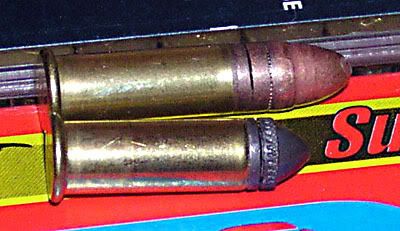
CB caps and Super Colibris have no gunpowder in them. What they do have is a whole heckuva lot of priming compound. I am pretty sure the reason the bottom of this casing is green, is because that green stuff is all primer.
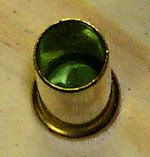
Also, the layer of primer is probably thicker, inside what looks like a slightly thicker rim on the Aguila casing.
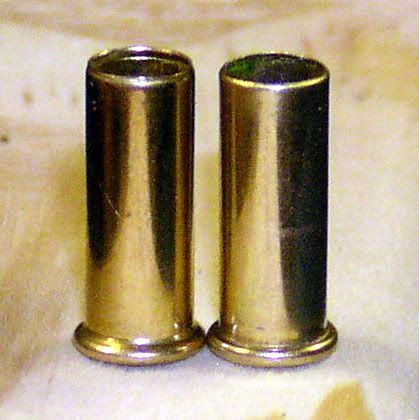
Standard high-velocity .22 rounds have about 1 grain of powder, each. My first idea was to simply dump out that grain of powder and fire the standard cartridges with just the primer for a propellant.
Q: How did it go?
A: Let me tell you, it was squibtastic!
During the process of working up loads that work for you, be prepared to clear several squib rounds. Failure to remove a bullet that is lodged in the barrel of your gun can quite literally kill you and/or destroy your weapon. I was happy to find out that clearing a squib in my rifle usually takes less than 20 seconds (if it's really stuck), not counting the time spent grumbling about it. Get used to the idea of squibs, because you will have them if you do this the "safer" way. The "less safe" way is to skip ahead and just do what I ended up doing.
So I said, okay, let's put a couple of granules of powder in the casing, reseat the bullet, and go for it. I remembered the possibly-an-urban-legend phenomenon of underloaded ammunition causing exploded rifles, so I started this thread at The Firing Line. The answers I got were . . . somewhat less than conclusive. I thought about it some more and decided the risks were acceptable, and to just take the chance.
At first I tried 6 granules of powder. The bullet got the same 2" down the bore as with the primer only, and lodged there. I got the same result with 12 granules. The report with 12 pieces of powder was about exactly as loud as my marlin's action firing, plus one gnat's fart. My notes say: "notable pip." 50 granules of powder got 4" of bullet travel and a noise about like firing a 10-pump pellet gun with only one pump of air in it. If you are loading cartridges for a short barreled pistol, then you might only need this very small amount of gunpowder. The bullet's trajectory is likely to be, as airgunners say, "bloopy." With 80 granules I heard a "pingpoof" and the bullet only went 3".
Next, I put in 130 granules and the bullet actually left the other end of the barrel! The noise was an odd combination of the Marlin's action recoiling a very small amount, not nearly enough to eject the empty casing, and then the noise of the bullet penetrating a cardboard box I was using for a target. The report of the gunshot was drowned out by the noise from the gun itself, and then I heard the bullet bouncing around inside the box. It was recovered largely undeformed aside from the rifling marks. I also noted from examining the spent casing that the rifle was running DIRTY. This is a product of two things: 1) I was experimenting with some nasty dirty-burning Remington ammunition that I got for free, and 2) Low pressure loads have a tendency not to burn all their powder cleanly, leaving residues behind. I loaded the next shell with 110 granules and that gave me a ping from the striker, then a strange suction cup-slurping noise. The bullet made it to 6" from the end of the barrel and stuck there. Next I tried 120 granules. PINGthhpp! again, and again 6" shy of exiting the barrel. Okay, let's try 150. The bullet was not very tightly sealed in the case, and the rifle was dirty as sin by now, so once again, we came up 6" shy of actually firing a bullet out the other end of the barrel. The suction sound I heard, I am pretty sure was the noise of the expanding hot gases, cooling and shrinking again, and drawing air in to the gun's action.
I started to wonder how close I was getting to full-charge loads at this point, so I pulled another bullet, dumped the powder, and counted it. The casing held around 670 granules of powder.

I figured I had a decent chance of getting a bullet to fire reliably from my rifle with about a third of that amount, so I divided the powder three ways and loaded three more cartridges with it. All three sent the bullets into the cardboard box with some authority, and caused that very slow not-quite cycling of the Marlin's semi-auto action. For grins I fired another Super Colibri and it was MUCH (2-3x) louder, with MUCH more smoke, and (judging from the interval between firing and the bullet striking the target) it was going way, WAY faster then my handloads. With my DIY rounds, there is a pronounced pause between firing and impact, and that's at a range of about 10 feet! The hardest of the hard core shooters will recognize the need for a good trigger pull follow-through here. Then I fired a Remington casing with no powder or bullet, just for grins. It gave a PING and a little poof and a tiny whiff of smoke came out the end of the barrel.
Pulling the bullets: I don't have a set of pulling dies for .22LR. What I do have is ingenuity, thank God. I made up a bullet puller of my own design, inspired by this centerfire-only Quinetics Kinetic Bullet Puller. I thought about the potential for setting off the primer of a rimfire round using this method, but in the end I figured the impact forces would be low enough with ME operating the machine to not worry about it. I made this high-tech bullet puller and it works great:

That's a piece of scrap "1x2" lumber, with a hole just slightly larger than the diameter of a .22LR cartridge. I was holding the exactly-right size bit by hand when the hole was made, so it ended up with both ends of the hole slightly oversize and the center a loose slip-fit on the body of the casing. The hole was drilled all the way through, so that loose bullets could come out the other end or be pushed back out, instead of clogging up the puller.
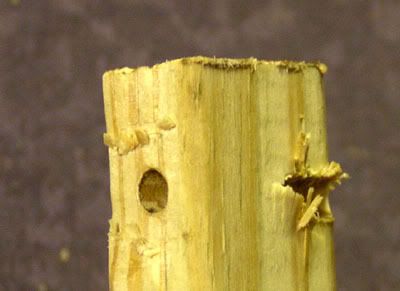
Blue painting prep tape is a good cover for both ends of the hole because it doesn't stick too hard, and it can be re-used repeatedly.
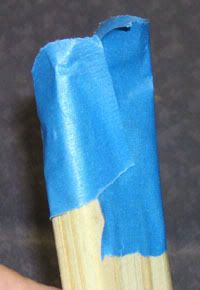
The stick is long enough to impart a good whack to the cartridge, but short enough to be handy. The rim around the hole where the cartridge goes in was shaved flat, perpendicular to the axis of the bore to avoid damaging the cartridge rim (or firing it!).

Insert a cartridge, tape it down, and give a few whacks (with the bullet end striking the whacking-target, duh! ) against something harder than your couch cushions. I mostly hit a mallet, like this:
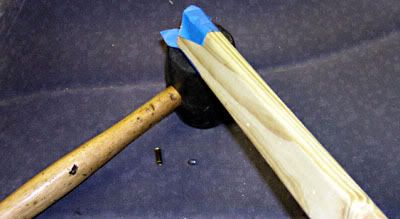
I also had success hitting the puller against another piece of wood, and the concrete garage floor as well. Initially I was not sure if this method of pulling a rimfire bullet would set off the primer, so I used a Super Colibri to test it instead of a high-velocity round. Result: no discharge. During the course of pulling a couple dozen bullets or so, I noted a tendency for the bullets to sometimes begin to come out at an angle.
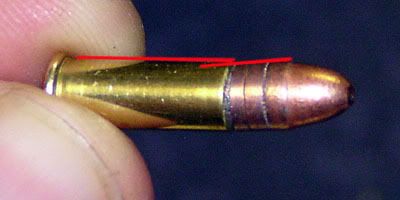
If the crookedness of the bullet bothers you, it doesn't seem to hurt to smoosh it straight, or push it back into the case to try again. If they are far enough out of the casing to have an angle to 'em, a hard tug with bare fingers may be enough to get the bullet the rest of the way out. Just be sure to hold the cartridge bullet-end up, or you will end up with gunpowder everywhere. Also remember not to whack too hard with your bullet puller, or the bullet may release, penetrate the tape, and go flying across the room. Then you get the powder mess and a lost bullet.
I also tried a different setup for pulling bullets, resulting in technical success but practical failure. I used a hard plastic cylinder with a just-right inside diameter, and with a lid that secured the cartridge from flying away, but the lid was loose enough it allowed the cartridge to rattle around inside the puller. The jostling the cartridges received was enough to shatter the priming compound right out of the rim of the case without firing it. My goal was not obtaining priming compound, though, so fail. With no primer, the casing will reload into a dud round.
I attribute the success I have had with my DIY kinetic bullet puller to a combination of a very slightly oversize hole (thousandths of an inch, I mean) along with the softness of the wood. The cartridge can rattle a little, but not smash hard enough into the puller to break the primer.
Once the bullet is free, dump the powder into a small, sealable container, or divide the charge however you are going to do for reloading. Load as much powder as you are going to into the waiting empty casing, and then push the bullet back in. A very firm push with both hands is usually enough for me, but I have a pretty strong set of pincers. I found a small "C" clamp works also, but tends to mar the nose of the bullet. People with a seating die could use that.
I noted on a few bullets, especially those with score marks from hitting the case neck at an angle on the way out, a little bit of lead squeezed off the base of the bullet and stuck around the opening of the case:
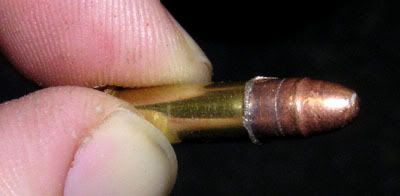
This is easily removed with a fingernail. Due to inconsistencies in this pulling and reloading process, the quality of the bullet-to-case neck seal is greatly variable. I imagine accuracy would be likewise spotty. For casual plinking, this is not a concern, but for rodent control or accuracy lovers, it is something to consider.
So there it is. With a little experimentation, you can have a custom-downloaded .22LR cartridge that is "safe" to shoot indoors, quiet enough (by a LOT) to use without ear protection, and without the 10x cost associated with Super Colibri or match-grade ammunition (match ammunition is almost all subsonic). You want cheap indoor trigger time at home? Here you go. You're welcome.
Q: What about recoil?
A: Seriously? There is none. You, pulling the trigger on your weapon, induce more rearward motion than the recoil from firing one of these rounds.
If any of my readers has a bullet chronograph, I'll be happy to update this page with your speed testing results if you "try this at home."
WARNING: If you think you are going to get cute and put more gunpowder in your .22LR cartridges, you may find out that the doctors and nurses at the local Emergency Department think the resulting explosion is a lot funnier than you think it is.
Final note: I KNOW reloading is frikken dangerous. We are talking about an unknown powder, even! But we are talking very, very small amounts of powder here, in a small casing, so relax. DO NOT try this procedure with higher powered handgun or rifle rounds. You just might get killed dead by your own exploding weapon. Don't. Also, rules 2 & 4 still apply, even with this wimpy stuff.


4 comments:
Very interesting experimentation. Some would point out some dangerous aspects of it, but I believe people have a right to chose their own risks.
Interesting, but not something I would find the time to do. There is a plethora of low powered rimfire ammo out there, and for lower velocity than that I would move to an air rifle. Perhaps growing up with a Sheridan in my hands leads me to that thought.
Indeed, the current solution is a Daisy. This took a bit more time than I'd have wanted to go through if I didn't have a bug in my ear about it. I wouldn't have even done it, if someone else had that I could find online. I couldn't find it, so I did it myself. Then I hope I saved the next guy the trouble by publishing it.
I'm planning to make Aguila SSS equivalent rimfire cartridges. And because they are very much not-so-available at the moment (here), one have to make them.
If you are not familiar with Aquila SSS, read this:
http://guns.connect.fi/gow/QA5.html
I'm planning to shorten 22 LR case and probably cast heavier bullets. Lapua used Vihtavuori 3N37 powder in rimfires, so it might be proper powder for my tests (or some equivalent "slow" burning pistol powder, 320 and up).
I know that some guy made tests with 22 LR and got some reloading data from Lapua, but that forum isn't very accessible nowadays and he made only hot loads.
By the way, why did you count those powder grains? Scale is kind of cool invention. Othwerwise, great article!
Scales are great if you have them. I counted the grains because I didn't know how many of them would be required to do what I wanted to do. Once I got the general idea, I made sort-of a guess that 1/3 charge would be ok and it was. No counting or weighing required.
If you *really* wanted to be like Aguila, you would play with some nitroglycerin or whatever primer is made of, and make a hot-primered round just like they do. Of course, that would be a little bit more likely to blow you up a little bit but hey . . .
Post a Comment